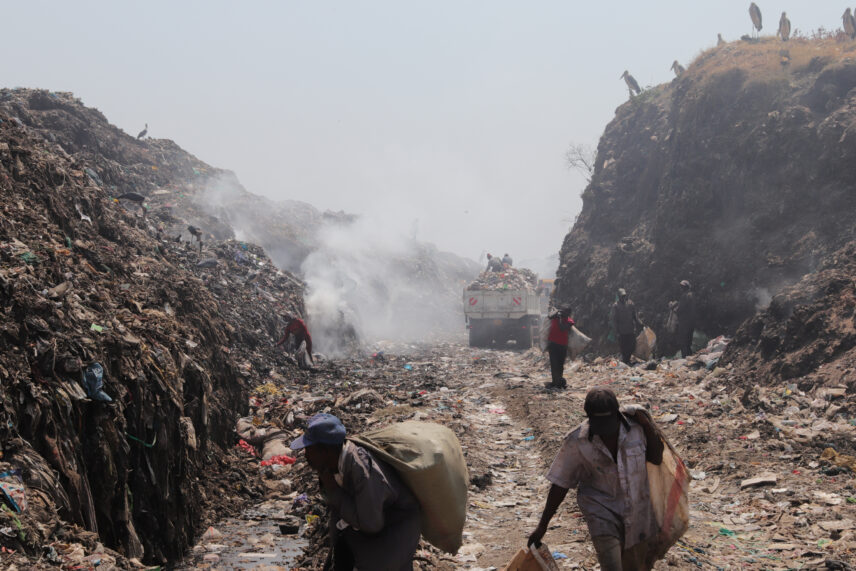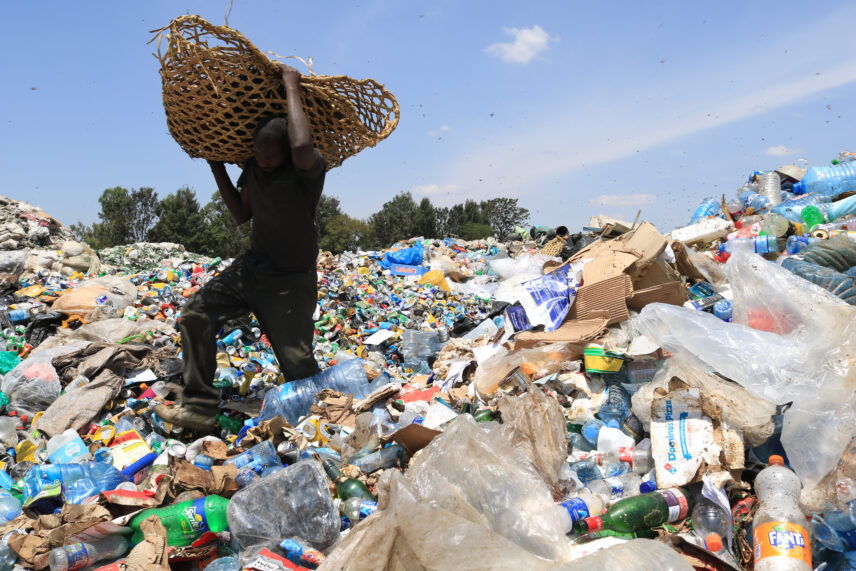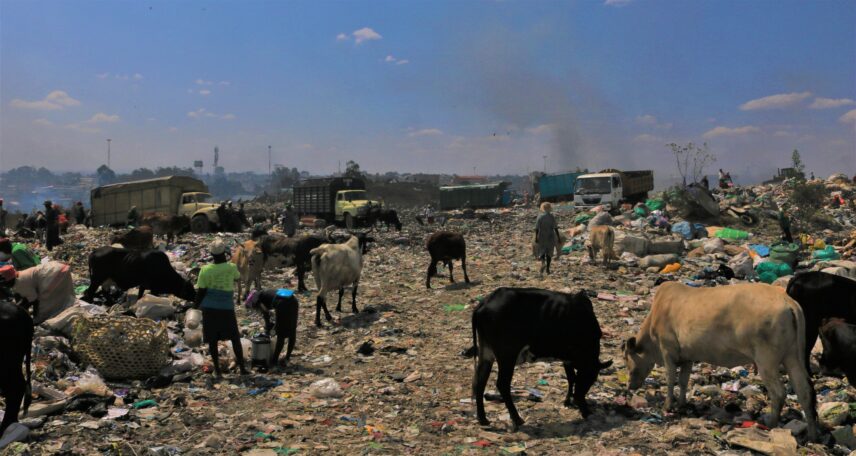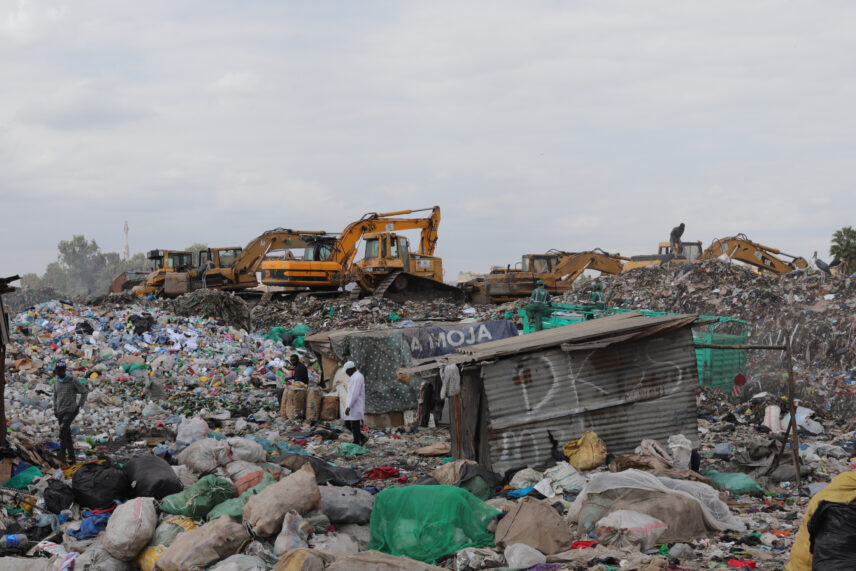Article begins
“In Boma nothing is waste,” Wambui tells me, as we sift through a mound of garbage. We are collecting chirambe, pig food made from a mix of organic waste from homes, restaurants, and fast-food joints in the city center: chicken bones, leftover pasta, pieces of chapati, rotten fruits, half-eaten slices of pizza, pineapple peel, avocados. Picked with bare hands and placed in nylon bags, the chirambe must be carefully reloaded onto the truck from which it was dumped, the bag well knotted and marked with a colored ribbon so that when they are unloaded again at the baze (a structure made from scrap materials where workers hang out and develop their networks)that will resell them, the manager knows to whom they should attribute the profits. “Mine is the blue ribbon, the heavenly one is from my sister, the red and light blue ribbon is for someone else.”
Located 7.5km from the center of Nairobi, Boma, the nickname for the municipal dumpsite, is surrounded by the low-income suburb of Dandora and the informal settlement of Korogocho. From its beginnings in 1981, as a small site in a Korogocho quarry, the sprawling dump now covers approximately 30 acres and receives about 650 tons of waste a day. The location of Boma and the decision to take Nairobi’s garbage to the Dandora dumpsite was and is a matter of moral, political, and economic choice because the surrounding area was inhabited by people considered waste, chronically excluded and unemployed. There is no gas exhaust equipment or leachate drain installed in the dumpsite, no covering of the waste with soil. The whole site is left in a bare state: the acrid odor spreads into surrounding neighborhoods and beyond, fills schools, churches, and homes. People work side by side on the trash plateaus with wavering 12-wheel lorries, bulldozers, and huge scavenging marabou.
Yet waste in Boma is not a symptom of decay, death, loss, or abandonment but is reclaimed as an opportunity and a possibility—to earn a living and to look to the future.
Around us about 10 women are all doing the same kind of work, and the truck we are working on is only one in a long traffic jam on the private ground, the heart of the dumpsite, where private companies dump from the richest neighborhoods of Nairobi. A truck coming from the Central Business District (home to several four- and five-star hotels, famous fast-food chains, the parliament), the wealthy neighborhoods of Westlands, Parklands, or Muthaiga, and Jomo Kenyatta International Airport can carry real treasures. We work to the rumble of engines and the shouts of drivers.

Joining the work on the private ground is not for everyone but only for trusted people, mostly women, who know and respect the sheria, the unwritten or informal laws of the garbage collection that direct the flow of materials to the bazesand on to recycling companies in the industrial area. The work of truck drivers, waste pickers, managers, and big men is all geared towards sorting the waste that can be sorted, resold, and recycled. Although the dumpsite officially belongs to Nairobi City County and the waste management is run both by private and public companies, the work of waste pickers inside Boma is considered jua kali—part of the informal economy.
Institutions and companies allow and motivate this side regime of waste management to fill the gap in public resources and to try to ensure economic opportunities for local residents. The roots of Nairobi’s waste management problems are long-standing: founded as a garden city for British settlers, African neighborhoods (located in the eastern part of the city) were systematically neglected and, following the racial principle of separate development, they had no right to the city. In recent times, a demographic explosion (and consequent increase in the production of garbage) worsened the situation, bringing the government to promote the jua kali as a strategy to mobilize resources for the city and its citizens while continuing a politics of underinvestment.
But the wastework is not only a pragmatic solution to waste management shortfalls or a survival strategy for vulnerable populations: it is an investment in mutual trust, a construction of social belonging, and a way to refuse social death and create an open future, full of hope. Writing about the “hustle economy” in Mathare, another informal settlement in Nairobi, Tatiana Thieme shows how youths manage waste in their neighborhood to “negotiate their place but also their time in the city.” In Boma, the waste pickers turn the unvalued and unwanted into valuable possibilities for their lives. The jua kali work is a way to transform urban uncertainties into opportunities; it involves a complex correspondence of actors inside and outside the dumpsite and new alignments between people and materials.
Wambui has been working in Boma since the early 2000s, when her father left the family and her mother introduced her to the dumpsite. She is 29 years old and a single mother of two young boys. Her hands move quickly and confidently into the heap of fresh trash, selecting and bagging food waste, cartons, metal scraps, and recyclable nylon bags. Following the sheria, Wambui splits the small plastic materials from the big plastic. Recognizing these two types of plastic and directing them into the right sack is what allows Wambui to access the private ground and to earn her salary when she sells her finds by weight.

Big and small are categories that do not just mark size and quality of plastic; they are indicators of property. Big is all that belongs to the owner, the big man who has bought the truck and its load of waste products, and it must be stuffed in the dabala (a large 70kg sack); small is everything else, which at the moment of the collection does not have a great market value and is not profitable for the big man’s business. The basis of this difference lies, ultimately, with the arrangements that the big man has with the recycling company: when his baze contains a certain weight of plastic, he can direct a truck to the industrial area and make his sale.
“All I need are my hands and my gunia (bag),” Wambui tells me during a moment’s break, and she explains how to distinguish the discarded materials by giving them a squeeze and listening to the sound they make: “You should feel the materials: this sounds, this not. You can’t collect for yourself those that sounds, because they are for the owner of the lorry.” She continues, elaborating on the relationship between waste pickers and the big men, on the reclaiming of discarded materials: “If you collect the big plastic in your guniayou will be in trouble [laughing], it’s not right! Those are money! You must collect the small materials because we are working for the owner, to help him, and he’s paying us with small materials. Ni sheria [it’s the rule], because tomorrow you want to come back here and work.” The relationship between the big man and the “small people” is fragile because it is based on interdependence and, although asymmetrical, is not understood as exploitative. “He can’t work without us! We are part of his business, what can he do without us? He can’t do anything alone with all those trucks—we have to help him, and he pays us. We help each other, with respect.”
After about three hours of scavenging and collecting on the ground, we return to Wambui’s baze, carrying with us the two gunia full of small materials. Before being sold, the materials must be cleaned, and a further differentiation must be carried out. We overturn the two gunia in front of us, and Wambui places three new bags, each of which will accommodate more specific materials. “Here carton, the brown one; here plastics and metals; here the plastic envelopes and bags,” she instructs. After more than an hour the bagsare full, and we are ready to measure our efforts. We clean any remaining fragments off the workspace and head towards one of the mtu akupima, the man of the weighing hook, a middleman with his own baze and trash business. We have picked 8kg of small materials, 7kg of plastic bags, and 35kg of cardboard for a total of 330sh, to which 100sh are added from the sale of two bags of chirambe. Meanwhile, Anthony—the manager working for one of the big men, since they don’t get their hands dirty—records the three dabala of big items in a notebook. These are now in his baze, ready to be stored and then loaded on the truck heading to the industrial area of the city. He scrolls through the register with a pen, checking the balance of the weight collected in the last few hours, “192kg. Something is missing here. As always.”

Compliance with sheria is the core of the waste economy in Boma not only because it provides a direction to the flows of materials, but especially because it enables modes of accumulation and redistribution of value that allow inclusion and participation in the well-being of the metropolis. The big plastic goes to the managers working for the big men who will sell it on to the recycling firms, and in return for sorting this valuable trash, the waste pickers can take their pick of the small materials and receive payment from these middlemen managers. The city’s waste is processed and managed. In her work on waste management and recycling in Rio de Janeiro, Kathleen M. Millar describes how garbage acts as a medium through which the community of the favela of Jardim Gramacho forges ties with the whole city, instead of being marginalized because of it. However, she suggests that such forms of inclusion in the economics of trash can be detrimental: Rio’s catadores endure relations of inequality materialized in the hard working conditions, in breathing in toxic smoke and miasmas. “It kills you slowly,” as Wambui puts it, referring to her weary lungs as well as to her feeling of going nowhere, of waiting, and of being stuck after hours of hard work. But waste in Boma is not a sign of urban deterioration and dereliction, it is reclaimed as an opportunity and a possibility. Waste pickers’ daily uncertain experiences and turbulent feelings towards their work enable us to see how inequalities are reproduced and how they shape urban rhythms and what AbdouMaliq Simone calls improvised modes of living.
Wambui is well aware of the importance of her work for the city’s ability to process its waste, and she highlights the ways trash creates ties that hold together materials and people at various urban scales.
Waste has connected a lot of people. It’s waste but… it’s our treasure. And you can find waste… inside the waste! But everything in the garbage has value because these bottles are waste, these shoe soles are waste, carton is waste… and companies buy and recycle them. This is waste with so many connections. They help me, the owner, even City County makes some money from here.
Boma is far from being an end zone for unwanted people and things. It is rather a place of movement, of transformation, of people and materials becoming. And as such, it is political and contested, since not all actors have the same social and economic resources to shape and direct their life trajectories. The connections that the big men have towards the city through their middlemen and agreements with truck drivers and recycling companies give them a very positive feeling about their work and their future. For Anthony, in his big baze, “This is an opportunity to reclaim ourselves back to the society: youths have energy, know how to sacrifice themselves and to motivate through competition with other youths…and here we are trying to give youths hope for a better future.“ “Waste is the backbone of all you see here,“ he says, pointing at the structure of his three-room baze made from scrap metals, tires, gabions, and mabati (corrugated iron sheets). “These materials brought me here and gave me the opportunity to grow, to take me out from bad situations […] because we bring something back to society and even those people of the City County are our customers.” This, he explains, is the motivation that “gives us energy to have hope for a better future.” For people like Wambui, the perception of life’s trajectory is always between a feeling of moving forward to an open-ended future and the bitterness of being stuck. Wambui is proud of her job, because “here is where I find my daily bread, for me and my son”―it allows her to “live a good life,” to pay the rent and children’s school fees. Yet her feelings about the work are full of ambivalence. As she claims, “hii ni baze yangu!” (this is my baze!), she conveys a sense of belonging and affective investment. But she also explains that “my mind is not Boma, I’m here because of situations.” Wambui express bitterness about the life circumstances that led her to the dumpsite and describes her present as fragmented; she feels rejected by her father and then her husband.

Wambui might be proud of the work she does, but her words also express concern and precarity related to her place in the waste economy, “Do you see these bottles? Someone somewhere someday will drink from these bottles…but the government doesn’t want to understand and recognize us, they don’t take us seriously, they just use us and give us false hopes.” Politicians show up during electoral campaigns to promise secure and stable jobs with companies and NGOs that will hire the waste pickers. Yet such promises remain unfulfilled.
Political promises don’t find a consensus among everyone in the dumpsite. Those with the largest share of the cake don’t envision themselves having more to gain if hired by a waste management company or if Boma is moved elsewhere to alleviate the environmental impact on surrounding neighborhoods. In Anthony’s baze, everyone is aware that projects to upgrade the dumpsite would never find an easy road, because big men and politics are tied together in a strong patronage network―they are one another’s clients. Big men won’t allow any upgrading to be fulfilled without their say: Anthony’s business network is too profitable to let it go. On the other side, Wambui expresses to me many times her wish to find a new and more secure job, such as opening a beauty salon or a shoe shop, because “these lorries sometime they come with nothing, sometime they come with some…sometime they are late, sometime you can take something there to sell, but some other day you get nothing, but…not all are the same…we are here…[laughing].” Wambui would gladly accept a job with a waste company or financial compensation if forced to leave the work with trash. But political promises and rumors of development come and go―nothing has changed.
For now, Wambui will be at Boma every day, carrying her bags, picking and sorting the plastics. She laughs, “I’m living a good life, I want to move to another level! I’m gathering pieces to live a better life!”

